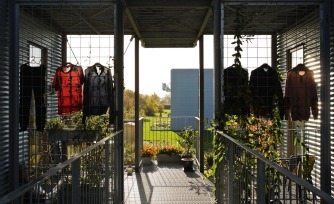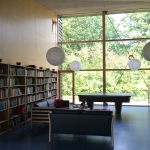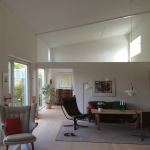In September 2014 ANA has been travelling and researching through Denmark, Sweden and Norway We have talked to various stakeholders in housing architecture; architects, municipalities, projectdevelopers, housing corporations, private clients, architecture schools, builders etcetera.
In 2,5 weeks we had 40 meetings, visited 8 cities and saw numerous projects. This first pilot trip was very inspiring in many different ways.
A different context generates new perspectives.
In recent years, the housing debate in the Netherlands has been strongly determined by de financial crisis. This crisis has not affected Denmark, Sweden and Norway as much as it did the Netherlands. In these Scandinavian countries, the debate on housing architecture has focused on other issues. For instance, the high pressure on the housing market has both in Sweden and Norway strongly dominated the debate. Also in these countries (architectural) quality is under pressure, but for other reasons and with other outcomes.
The Dutch have a good reputation for innovative architecture. One of our research questions is what will happen with innovation under the new more restrained circumstances. If you look at the Dutch situation from abroad there is still much innovation. The new circumstances have caused a vacuum that has generated innovative solutions. To name one example, the introduction of the smaller scale in developments, that is clearly visible in Amsterdam (Houthavens, Buiksloterham, Zeeburgereiland), is something that the Danes also want very much, but are unable to develop due to high market pressure.
Architects reclaiming their role
During our first trip to Scandinavia we have met many passionate architects that have the ambition to make good housing projects. The role of architects in housing is under pressure in all countries we have visited, but in some more then in others. Some of the architects we met are developing interesting strategies to reclaim their role.
Especially in Sweden architects involved in housing complain very much about their limited role. In Sweden builders have a very dominant role and determine construction methods up to a detailed level. Architects are often not commissioned for the later stages of the design and the building process. For instance Tengbom, a firm with around 500 employees and offices in twelve cities, is focusing on how they can add value for the client. They offer performance instead of hours, in order to reclaim and strengthen their role. White architects, an even bigger firm with over 700 employees and offices in thirteen cities, has shown us another way in which they are able to make high quality housing. In Äppelträdgården they have taken over the role of the client and worked together with a building company to design, build and sell innovative housing types in a poor neighborhood.
The new housing assignments
During the meetings we have focused on the future housing assignment. We found several issues that overlap with the Dutch situation, but also many differences in the way these issues are addressed.
Making livable and divers cities that provide housing for all social groups is an important issue in all the places we have visited. Building affordable housing is a recurrent topic, but the solutions differ very much, going from building small & clever, new financial strategies to using prefab building systems. Related themes are keeping families in the city, creating housing for the new generation elderly Europeans and providing affordable student housing.
Taking care of environmental issues is also a returning topic that has different emphasis in the different countries; the Swedes are taking good care of waste, whereas the Danes focus more on mobility issues.
Quality under pressure was in every meeting we had a recurring topic. Even in good economic circumstances that all three Scandinavia countries are blessed with, quality is not taken for granted. Quality has numerous definitions, defined very much by what is missed. For instance in Norway quality is defined as space, in Sweden it’s experiment and in Denmark quality is defined as creating good public/private relations.
Striking was also that we missed some themes that are part of the Dutch debate: the participation of citizens, populism in housing architecture, private plot development, dealing with the existing housing stock. These themes are not necessarily not relevant, but they are not being debated.





























